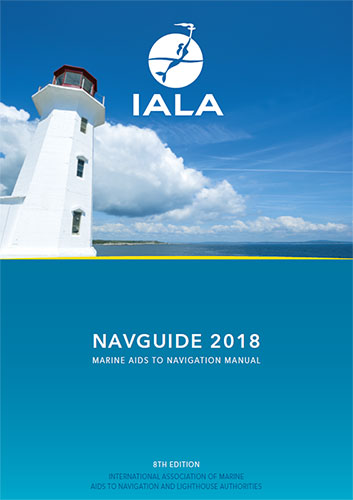Navguide Marine Aids To Navigation Manual 2018, Eighth Edition. Руководство по морским средствам навигации
The Guide is a product of four years collaboration by the world’s leading experts on Marine Aids to navigation, produced by the four primary Committees, Aton Requirements and Management (ARM), Aton Engineering and Sustainability (EnG), e-navigation (EnAV) and Vessel traffic Services (VtS). the ARM Committee has the primary oversight for its editing and production.
The Guide plays an important role within the iALA information suite and is regarded as a primary source of information for Marine Aids to navigation practitioners around the world, along with the iALA Standards, Recommendations, Guidelines, Manuals and other publications.
Contents
Foreword
Chapter 1 - Introduction to IALA-AISM
1.1 Purpose and Scope
1.2 Background
1.3 Membership
1.4 General Assembly
1.5 the Council
1.6 Policy Advisory Panel
1.7 Legal Advisory Panel
1.8 Committees
1.9 IALA World Wide Academy
1.10 IALA Model Courses and the IALA Accreditation Scheme
1.11 Conferences, Symposia and Exhibitions
1.12 Workshops and Seminars
1.13 IALA Publications
1.14 Related organizations
Chapter 2 - Concepts and accuracy of navigation
2.1 Navigation Methods
2.2 Accuracy Standards of navigation
2.3 Phases of navigation
2.4 Measurement Errors and Accuracy
2.5 hydrographic Considerations
Chapter 3 – Marine Aids to Navigation
3.1 Operational Requirements
3.2 Visual and Audible Marine Aids to navigation design theory
3.3 Visual Marine Aids to navigation technology
3.4 Maritime Buoyage System and other Aids to navigation
Chapter 4 - e-Navigation
4.1 Introduction
4.2 Background
4.3 IMo’s strategy for the development and implementation of e-navigation
4.4 IALA’s Role
4.5 Maritime Service Portfolios
4.6 Maritime digital infrastructure
4.7 Communications
4.8 Positioning, navigation and timing
4.9 Testbeds
Chapter 5 - Vessel Traffic Services
5.1 Introduction
5.2 Purpose
5.3 Definition
5.4 IALA VtS Manual
5.5 Objectives
5.6 Functions
5.7 Types of Service in VtS
5.8 Surveillance Requirements
5.9 Equipment Requirements
5.10 Personnel
5.11 Promulgation of information
5.12 Summary
Chapter 6 - Other services and facilities
6.1 Pilotage
6.2 Ships Routeing
6.3 Minimum Comprehensive Mix of Aton for Channels and Waterways
6.4 The Marking of Man-Made offshore Structures
6.5 Nautical Publications
6.6 Tide Gauges and Current Meters
6.7 Under Keel Clearance Management Systems
NAVGUIDE – 2018
Contents
Chapter 7 - Power supplies
7.1 Types
7.2 Electric - Renewable Energy Sources
7.3 Rechargeable Batteries
7.4 Electrical Loads and Lightning Protection
7.5 Non-Electric Energy Sources
Chapter 8 - Provision, design and management
8.1 International Criteria
8.2 Level of Service
8.3 Risk Management
8.4 Availability objectives
8.5 Reviews and Planning
8.6 Quality Management
8.7 Maintenance
8.8 Service delivery
8.9 Environment
8.10 Preservation of historic Marine Aids to navigation
8.11 Human Resources Challenges





 Эксплуатация эхолота НЭЛ-20 К
Эксплуатация эхолота НЭЛ-20 К  Система передачи навигационной информации. Судовой приемник FAX-208 MARK-2
Система передачи навигационной информации. Судовой приемник FAX-208 MARK-2